| Published
on 15
Dec 2023 |
All rights reserved.
|
|
|
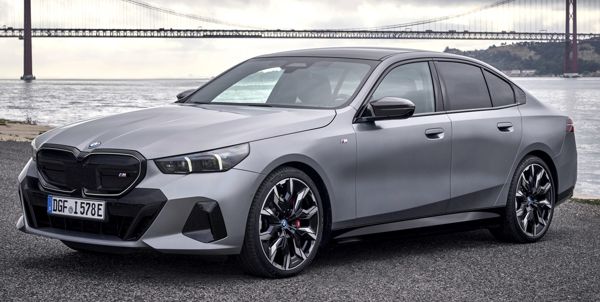 |
|
The
G60 faces the biggest challenges in the 5-Series' history. Can it
succeed?
|
|
How to describe the new
generation BMW 5-Series with codename G60? It is the first 5-Series to
offer both ICE and electric power options, with the latter badged as
i5. It is very likely to be the last 5er you can have with combustion
engines, so it carries a lot of weight on its shoulders. All-new design
language and a digital interior complicate it further. So many
challenges, so many work to do, it has all sorts of reasons to
disappoint, but at the first glance, it looks not a bad effort.
Firstly, the new exterior design is not as shocking and polarizing as
recent efforts such as XM, M3 / M4 and 7-Series. Yes, the double-kidney
grille is larger than ever for a 5-Series, but nowhere as huge as its
siblings. The bonnet is heavily sculpted to emphasize the shape of the
kidney grille, which have 2 different designs. The front end is still
overstyled and looks a bit busy for my taste, but the entire car is
quite sleek, as shown in its lowest Cd 0.23 for the base electric model.
To accommodate the underfloor battery for the i5, the G60 inevitably
gets taller. Normally, this should mean a raised waistline and roofline
hence a bulky look that could be mistaken for a crossover. Fortunately,
BMW's designers blacken its side skirts and the bottom of rear overhang
to make the body sides appear slimmer. By using a longer yet more
sloping bonnet, a very fast angle rear window and much slimmer
C-pillars (which recall our fond memory of the 1980s BMWs), the
passenger cell looks smaller and lighter, and the whole car appears
slimmer and sleeker. No, it cannot hide its bulk entirely, but better
than expected. Had its designers toned down the front end design, the
G60 could have better matched the handsome looks of its G30 predecessor.
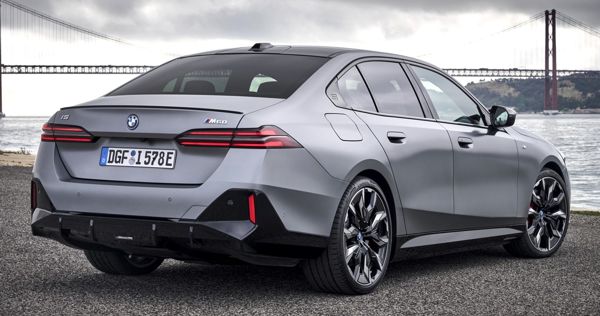 |
|
No
matter styling or dynamics, it cannot hide its bulk entirely, but it
does better than expected.
|
|
Unfortunately, part of the design trick comes at the price of extra
metal. The G60 might not be larger than its predecessor for cabin
space, but it employs a lot more metal and gets on quite a lot of
weight. Overall length is stretched by 124 mm to 5060 mm, the first
time exceeding 5 meters. Likewise, width gains 32 mm to 1900 mm while
height grows by 36 mm to 1515 mm (again that battery!). Wheelbase is up
by a relatively modest 20 mm to 2995 mm. You expect the longer rear
overhang should boost luggage space? Sorry, it actually drops by 10
liters to 520.
BMW's CLAR platform, as demonstrated by the 4-Series and i4 already, is
flexible enough to accommodate ICE power or electric power without much
performance drawback, but a common structure means weight cannot be
optimized for either power versions. That's why a rear-drive 520i now
tips the scale at 1725 kg (DIN), almost 200 kg more than its
predecessor.
Admittedly, the 520i gets more efficient than ever. Now its 2-liter
Bi-Vanos and Valvetronic engine runs at Miller-cycle and has a 48V mild
hybrid system incorporated at its transmission. The engine produces 190
hp and 229 lbft. In addition to the mild hybrid motor, system output is
208 hp and 243 lbft, enough to propel the big BMW from 0-60 in 7.1
seconds and flat out at 143 mph, which is very efficient thanks to its
0.24 Cd.
Another entry-level model is 520d, whose 2-liter sequential twin-turbo
diesel engine produces 197 hp and 295 lbft, manages to do 0-60 in 6.9
and top 145 mph, though this diesel model is no longer offered in most
markets.
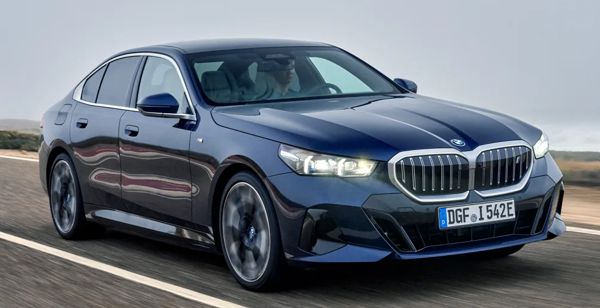 |
|
Vast
range of engines, electric motors and plug-in hybrid powertrains to
choose from. |
|
European motorists demanding more
performance without switching to i5 will need to wait for 530e plug-in
hybrid, whose transmission-incorporated motor adds 184 hp to the 520i
petrol engine, taking the total to 299 hp and 332 lbft. Its 0-60 mph
time of 6.1 seconds is not as remarkable as expected, because the car
is 280 kg heavier than the 520i. Likewise, its unchanged top speed is
achieved without the assistance of electric power, because the motor
cannot spin as fast.
If you live in America, you are lucky, because BMW offers the more
conventional choices of 530i and 540i xDrive there. The 530i uses a
more powerful version of the 2-liter four, which produces 258 hp and
295 lbft for 155 mph and 5.9 seconds 0-60. Meanwhile, the 6-cylinder
540i xDrive pumps up the numbers to 380 hp, 398 lbft (boosted by mild
hybrid) and 4.5 seconds.
Yet the 540i is not the range-topping non-M model. That place is left
to the new 550e xDrive plug-in hybrid. It mates the 3-liter
straight-six engine (though detuned to 313 hp) with an electric motor
and battery system similar to that of 530e, producing a combined output
of 489 hp and 516 lbft. 0-60 mph is improved to 4.1 seconds, although
the car is predictably very heavy at 2155 kg. Both 530e and 550e
deceive WLTP test method very well, achieving carbon emission of merely
13 and 19 g/km, respectively. This means, while keen drivers might
prefer the much lighter 530i and 540i, their employers might end up
choosing the plug-in hybrid models as company cars.
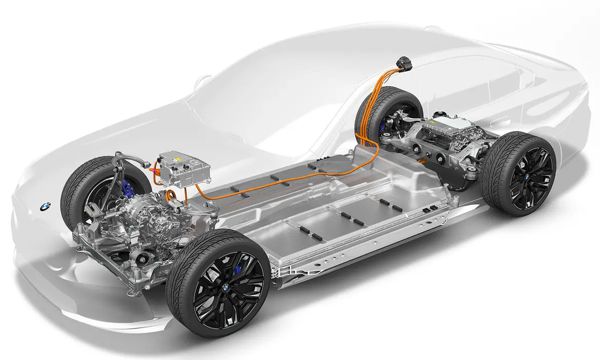
|
|
Until
M5 arrives, i5 M60 xDrive is the fastest and the most fun to drive.
|
|
Regarding i5,
there are 2 models at launch, and both are derived from the component
set already seen on the smaller i4. The i5 eDrive40 employs a single
rear motor to provide 340 hp and 317 lbft of torque. 0-60 mph takes 5.7
seconds and top speed is limited to 120 mph. Meanwhile, i5 M60 xDrive
uses front and rear motors to produce 601 hp and 605 lbft in Sport
mode, good for 0-60 in merely 3.7 seconds while top speed is slightly
higher at 143 mph.
Predictably, both i5 models are heavier still. The rear-drive eDrive40
weighs 2130 kg while dual-motor M60 weighs 2305 kg. Both cars share the
same 84 kWh (gross) battery which returns respectable range, especially
eDrive40. On the downside, BMW's 205 kW DC quick charging is not
exactly top notch on the market. A charge from 10 to 80 percent will
take half an hour. For comparison, a Hyundai Ioniq 5 N, also has an 84
kWh battery, takes just 18 minutes for the same task thanks to its 350
kW capability. It goes without saying that BMW’s 400V battery system is
not as advanced as the 800V design of Hyundai-Kia, Porsche or some
high-end Chinese EVs, let alone the 924V system on Lucid Air.
As for chassis, there is not much surprise, because most development
budget has been directed to electrification, infotainment and driving
assistance tech. Just like other CLAR platform cars, the 5-Series and
i5 employ double-wishbone front and 5-link rear suspension. Adaptive
dampers, active anti-roll bars and rear-wheel steering are optional on
all versions except i5 M60, which has them fitted as standard. Besides,
like i4, all i5 models get standard adjustable air springs at the rear
axle to deal with their immense weight and provide ride height
adjustment.
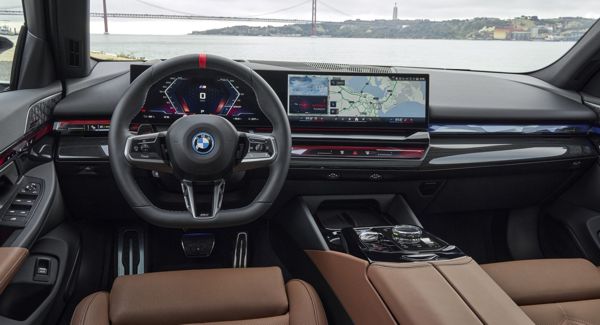 |
|
We
would prefer BMW to save money on gimmicks and spend more to improve
material quality...
|
|
Inside, the G60
features BMW's latest digital technology, including a curved digital
display which combines a 12.3-in instrument and 14.9-in infotainment
touch screen, but it retains the iDrive's rotary controller on the
transmission tunnel. It might be easier to use than most other “modern”
cockpits, but the need to use touch sensitive slide bar to adjust the
hidden air vents is annoying, while the interactive light bar that runs
across the dashboard are more design gimmicks than an improvement. We
would prefer BMW to save money on these gimmicks and spend more to
improve material quality, because some harder plastics found at the
lower half fail to match the 5-Series’ pricing. That said, other
materials feel suitably premium, especially when compared with Mercedes
EQE.
The G60’s cabin is no larger than its predecessor’s, but it has no
problem to seat 6 footers behind 6 footers. Predictably, the driver
seat is set higher than any previous 5-Series, but just slightly.
On the road, surprisingly, the ICE and electric models drive with a
similar manner. They still feel like BMW – good body control,
rear-drive balance, consistent behaviour and control weighting.
However, it doesn’t feel as agile as the old 5-Series or the i4, blame
to its extra size and weight. This is especially obvious on narrow
twisty roads and slower corners, or under heavy braking. No matter how
hard its engineers worked, they cannot deny the laws of physics. The
petrol models suffer less than i5 in this respect, but they still
cannot quite match the old car for agility. On open roads and at higher
speeds, the car behaves better, more in line with the tradition of
5-Series.
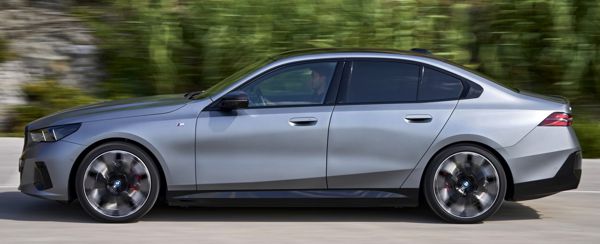 |
|
Still
drives like a BMW should, although inevitably less agile than the old
car.
|
|
Likewise, the extra weight and height have negative effects
on ride quality. Cars fitted with M Sport (passive) suspension feel too
firm on low-speed irregularities. Adaptive dampers are strongly
recommended, as they offer a more compliant ride in Comfort while
retaining control at Sport mode. To the heavier i5, active anti-roll
bars are also a worthwhile investment, because they soften the
suspension in normal circumstances.
As for powertrain, most 5-Series should not disappoint. The i5 eDrive40
might be slower than Tesla Model S or many other rivals, but its
performance is perfectly adequate for an executive car. Its power
delivery is smooth, the brake pedal feels linear, the cabin is quiet
and the general refinement is of very high level. If anything put you
off, that might be its slower charging or its £74,000 price tag.
But then it is a BMW.
Meanwhile, the range-topping i5 M60 is more remarkable. Yes, its
near-£100K price sounds insane, but it also offers outstanding
straight line performance and better handling than the base model –
all-wheel traction, massive grip from P Zero tires, better body control
and a more settled ride thanks to adaptive dampers and active anti-roll
bars. It is quite a lot more fun to drive. It will take an M5 to beat
it.
That said, the new 5-Series and i5 fails to set standards on the
dynamic side. From driver’s point of view, you will find the outgoing
G30 or the classic E39 unsurpassable. The G60 is in the process of
transition from combustion to electrification, and we all know that
will bring compromises. When the transition is complete, when battery
technology is matured, the next generation i5, 5-Series or however it
is called, will hopefully be back to the right track.
|
Verdict:     |
Published
on 8
Feb 2025
|
All rights reserved.
|
|
M5 (G90)
|
|

|
|
Heavyweight
hybridized M5 amazes for agility and capability, but it is too complex
to be a great M5...
|
|
For the last 40 years, BMW
M5 has been the definitive performance executive car, the one every
rival is judged against. Even though it faced stiff competition from
Mercedes-AMG E63 and Audi RS6, the M5 usually prevailed and kept
standing at the top. It started life with the classic BMW formula of
straight-six motor and rear-wheel drive, but throughout the years it
was brave to make fundamental changes whenever necessary, such as
changing from straight-six to V8, V10 and turbocharged V8; Switching
from manual to SMG automated manual, twin-clutch and torque converter
automatic transmissions; and converting from rear-wheel drive to
adjustable 4-wheel drive. However, I suppose none of the above changes
are comparable to the one introduced by the latest generation with
codename G90: hybridization.
Bigger, heavier and more powerful, that's what we have expected the new
M5 to become. However, what we didn't expect is that it gets slower.
Although the G90 tops the same 190 mph as the old car if M Driver
package is opted, its 0-60 mph sprint takes 3.4 seconds, one and
two-tenths slower than the outgoing M5 and M5 Competition,
respectively, let alone the last M5 CS which dipped below 3 seconds.
This is not only the first ever M5 that runs slower than its direct
predecessor but also the only hybrid conversion on the market that goes
slower than its ICE predecessor.
In isolation, the V8 plug-in hybrid powertrain seems to be a
considerable upgrade. It produces 727 horsepower and 737 pound-foot of
torque, 102 horses and 184 pound-foot up from the old Competition model
which had been the bulk of the M5 sales since 2018. However, the
increase of power is not as big as it could have been, because while
the electric motor – incorporated into the ZF 8-speed automatic –
produces 197 hp and 206 lbft, the 4.4-liter cross-bank twin-turbo V8 is
actually detuned from the Competition's 625 hp to 585 hp. The peak
power and torque last 200 rpm and 400 rpm sooner than before, implying
a more restricted top end delivery. Does BMW deliberately restrict it
to leave space for the upcoming Competition and CS?
However, the biggest problem is weight, which surges by almost 600 kg
to a Bentley-rivalling 2435 kg! This means its power-to-weight ratio
drops from the last M5's 323 hp/ton, the Competition's 333 hp/ton or
the CS' 348 hp/ton to only 299 hp/ton, no wonder it is slower. The only
thing it excels is in-gear acceleration, helped undoubtedly by the
torque-filled electric power.
How to explain the massive weight increment? Firstly, the G90 is larger
than ever, now measuring 5.1 meters long, nearly 2 meters wide and just
over 1.5 meter tall, a size should have been reserved for a 7-Series
until a few years ago. Secondly, the CLAR platform it employs is
compatible to not only plug-in hybrid power but also full electric
power in the form of i5, so the structure left underneath the cabin
floor is strong and massive. The need to accommodate ICE, PHEV and BEV
power means many areas need to be strengthened, resulting in
unnecessary weight. While a flexible platform is good for economy of
scale, it goes without saying it weighs more than a platform designed
for one particular usage. Lastly but not least, the car’s electric
motor and battery are taken straight from the lesser 550e plug-in
hybrid to save cost, so it is not a bespoke design by the M division.
Speaking of battery, the M5's 22kWh battery is a little bit small for a
PHEV. It gives a zero-emission range of only 69 km whereas most company
car tariff regulations require 100 km. At least, it is mounted low in
the underbody as in the i5, so there is no sacrifice to boot space.
Still, the M division applies adequate modifications to make the
largest ever M5 feel as small as possible, such as fitting 4-wheel
steering for the first time. There are also active differential,
variable 4WD and adaptive dampers as standard. The chassis is
strengthened, too, thanks to a shear panel that connects between
suspension towers and bulkhead, some tower-reinforcing bracings and
extra underfloor bracings. Both front and rear tires get 10 mm wider,
while the rear wheels are an inch larger at 21" (front wheels remains
at 20"). New flared fenders are employed to accommodate the wider tires
and tracks.
You can trim 30 kg by opting for carbon-fiber roof panel instead of the
standard panoramic glass roof, or a further 25 kg by ticking
carbon-ceramic brakes, but even so the M5 still tips the scale at 2380
kg, and the car's price will certainly rise beyond the £111,400
starting point. While it doesn't sound unreasonable for a PHEV upgrade,
taking the regressive performance into account and it appears to be
less sensible.

|
|
This
is the first ever M5 that runs slower than its direct predecessor...
|
|
On the Road
The first glance at the car gives an immediate shock: wow, it’s big!
Apart from massive length and width, the elevated shoulder line and
unusually tall roof – tell me which performance car exceeds 1500mm in
height? – all amplifies the sense of volume and mass, even though
designers tried to lessen that perception by a pyramid-style
greenhouse. Like the rest of the G60 5-Series range, it is a complex
design, not the most beautiful M5 but also not the ugliest either
(that’s the E60 for sure). However, those massive wheels and fat tires
accompanied with wider flanks do deliver a suitably sporty feel.
Save the M bucket seats and a few extra driving mode buttons, the
interior is the same as lesser 5-Series models. This means it is heavy
on screens and ambient lighting but a little disappointing for sense of
occasion or quality. Predictably, you sit higher than in the old car
due to the battery installed underneath, but not as high as most other
EVs. The bespoke flat bottom steering wheel has two red buttons marked
“M1” and “M2”, which store your favourite settings of drivetrain,
suspension, steering and stability control. They are very useful,
because the M5 has countless combinations of settings to explore and
understand.
Despite inferior standing start acceleration figures, the new M5 feels
stronger in the real world, thanks to the instant shove from electric
motor. As proved by Autocar’s road test data, its in-gear acceleration
at road speeds is noticeably quicker than even the last M5 CS, so
overtaking in real world driving situations is breathtaking. Unless you
stretch its muscles on unrestricted sections of Autobahn or a racing
track, it is hard to believe it gets slower.
The V8 might be down on power, but it is still eager to rev to 7200
rpm. Unfortunately, the noise it makes at full song is not the most
melodious, feeling a bit hollow and subdued, certainly not in the
league of an AMG V8.
As for handling, from the first turn you will be amazed how agile it
feels. The variable ratio steering is very direct and accurate. The
rear-wheel steering sharpens its turn-in and makes the big car feels
much smaller and lighter than it is. However, the car feels more
comfortable to drive on wide open roads, because on a narrow lane you
are always aware of its massive width.
Push harder, the suspension does a good job to limit body roll. The fat
Michelin Pilot Sport 5S tires generate enormous grip, likewise the
traction from 4WD system. The brake pedal feels sharp and reassuring,
too, but to withstand its 2.5-ton weight you’ll need optional ceramic
brakes to deliver a fade-free performance.
You may switch the 4WD system to RWD mode, but that will disable
stability control entirely thus should be reserved for track. 4WD Sport
mode is a better bet for road driving if you want to have some fun,
where the M5 feels suitably rear-driven, rotate slightly in corner
under power.
Nevertheless, push beyond its comfort zone, the M5 enters the territory
of uncertainty. Now you realize both its steering and suspension lack
the communication that its predecessors offered. It is harder to judge
what the car will respond at the limit – holding on, progressive slide
or snap oversteer? You can only trust its ability by experience, but
that is not good for driver confidence.
Likewise, when the road is smooth, the M5’s suspension displays
remarkable composure. It also rides reasonably well on country roads
with the dampers set to Comfort. Push it harder cross-country, however,
the dampers start struggling to contain the M5’s excessive mass, where
it fidgets over surface undulations. It is therefore hard to get into
rhythm like the last generation Competition or CS.
As a result, the big M5 is not as engaging to drive as its
predecessors. In many ways it is still remarkable: power, braking,
agility, body control and even ride quality, but it lacks the
transparency, consistency and simply natural feeling of the M5s went
before it. While its clever technologies are mostly successful in
hiding its size and weight, it fails to gel with its driver. Against a
Porsche Panamera Turbo E-Hybrid – in similar size and weight if not
price or class – the BMW might be a bit more interesting to drive
thanks to its keener turn-in and more playful 4WD system, but it is
still a disappointment to see it fails to repeat the all-round magic of
its predecessors. Let’s hope the forthcoming Competition and CS
variants could turnaround its reputation.
|
Verdict:     |
|